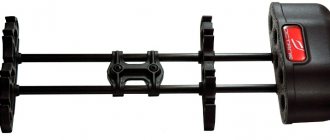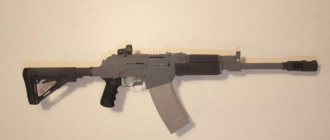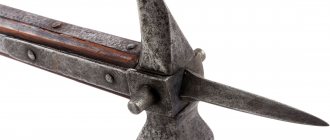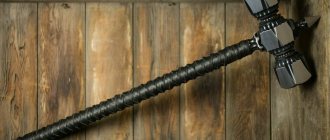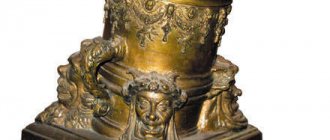A war hammer is a type of bladed weapon designed to deliver crushing blows to the enemy, functionally similar to a mace or club. Together with the spear and the axe, the war hammer is one of the most ancient types of bladed weapons; all of them were invented by man back in the Neolithic period.
The war hammer was very popular in the German lands (until the 11th century); it is believed that it was from there that it came to other European countries. However, the “golden age” for the hammer can be called the late Middle Ages, the time of widespread use of plate armor. During this period, the war hammer - along with the ax and pike - became part of the universal long-shafted weapon, with which it was possible to deliver piercing, chopping and crushing blows. After the disappearance of plate armor, the war hammer was still used for some time as a status attribute of the military authorities.
In addition to Europe, war hammers were very popular in the East. Varieties of these weapons were widely used at different times in India, Persia, China and Afghanistan.
The hammer, like other types of bladed weapons, had (and still has) great symbolic meaning in different historical periods. It is very widely represented in the mythology of various peoples of the world.
The war hammer is the true quintessence of pressure, pressure, power and brute force, invincible and all-crushing. However, it is characterized by a kind of dualism, since the hammer is not only an instrument of destruction, but also an instrument of creation. This is not only an attribute of war, but also a symbol of labor and creativity. The Scandinavian god of thunder and storm Thor used his stone hammer Mjollnir both as a creative tool and as a weapon of enormous destructive power. This hammer not only flew perfectly, but also always returned to its owner. In Japan, the hammer was a symbol of wealth and prosperity; this tool was an invariable attribute of the Greek god Hephaestus, the patron saint of blacksmiths and metallurgists. However, among some peoples, the hammer was a symbol of evil, a blind natural element, unpredictable and inexorable.
The hammer is a very common heraldic symbol, although in this area its “peaceful” form is more often used. The coat of arms of the Soviet Union featured a hammer and sickle; this symbol was often used by other lovers of leftist ideology.
A little theory
When hammering a nail, we do not think about the most complex physical transformations in the hammer/nail/solid body system. The efficiency factor (the ratio of useful work and energy expended to set the hammer in motion) is 70 - 97%. For most modern machines and mechanisms, this is an unattainable limit.
The main part of the energy loss is spent on the hammer recoil back, due to the occurrence of elastic forces. The amount of kickback depends on the material from which the hammer head is made and the properties of the material. For steel tools, energy losses are about 30%, for titanium tools - within 3 - 5%. But these indicators also depend on other parameters:
- type and shape of the impact part;
- handle material and length;
- tool mass;
- angle of contact;
- compliance of the type of hammer with the operation being performed.
The last item on the list is very important - in mechanical engineering, stone processing, and construction, various types of hammers with different levels of versatility are used. Among them, you can choose a tool for all occasions, for household and semi-professional use, and highly specialized ones, “tailored” to perform one or two operations, but with the highest efficiency.
The two main parts that make up the hammer - the handle and the head - are firmly connected to each other. When moving, quite large forces act on the massive head - when it slips off the handle during an impact, the kinetic energy of the head allows it to fly several tens of meters. If the slightest wobble occurs at the joint or cracks appear on the handle, the hammer should absolutely not be used. It becomes dangerous for the worker and others.
The head consists of several parts:
1. Sock; 2. Hole for the handle (mount);
3. Wedge; 4. Nail puller;
5. Striker; 6. Cheek; 7. Handle.
The firing pin, the head impact part, is usually flat, has sufficient area and strength to withstand a significant number of impact contacts with hard objects without deformation. The striking surface is flat or slightly convex. In cross section it represents a square, rectangle or circle.
The back of the hammer is, in most cases, wedge-shaped. This allows you to develop a significantly greater impact force by reducing the contact area. Wedge blows are used when it is necessary to split the material or mint it. The back part can be spherical, depending on the area of application of the hammer and its main purpose.
The insertion is made in the form of an oval or round through hole, the walls of which slightly widen from the center to the top to prevent possible slipping from the handle. On some types of hammers, there is a fitting around the mounting hole in the form of a metal collar that extends several centimeters onto the upper part of the handle. This part of the tool protects the handle from breaking if the blow is too strong or inaccurate.
The head is made of hard metal by forging, casting or milling. It is protected from corrosive effects by special types of paint or galvanic coating. Before applying the protective layer, the head is subjected to hardening, in most cases selective. The greatest hardness (up to 52 units on the Rockwell scale) is achieved by the striking part (striker). Hardening is carried out using the electrical induction method, which makes it possible to precisely regulate the depth of surface hardening. On the striker, the hardening depth reaches 3 – 5 mm.
The back part (wedge or nose) is hardened to 36 - 42, and the area of the mounting hole - only to 24 - 30 units on the same scale. The shape, weight, dimensions and other characteristics of industrial hammers are determined by GOST 11042-90 and 2310-77, which describe almost all types of hammers and their purpose.
Many manufacturers produce impact instruments according to their own specifications, which take into account most of the requirements given in national standards. The changes concern the use of new alloys, the length and shape of the handles, improved ergonomics, computer-modeled, and more precise surface treatment.
Other meanings of this word:
- I hit my ass with 3 clicks
- Farm laborer priest
- I worked as a laborer at Pop's (tale)
- stupid worker at the priest's
- Clueless man, fool
- big hammer
- in the Slovenian language this word means “block”, “log”, and in Russian dictionaries of the 18th century. its main meanings are "thickened end of a club", "sledgehammer"
- Hero of a fairy tale by A. Pushkin
- a fairly simple and common board game in which you need to form words using letters located on the playing field
- Fool Alexander Sergeevich
- the only worker in Russian fairy tales
- the devils paid him rent
- forced the devils to pay rent
- Which fairy-tale character ate spelled for four
- Which fairy-tale character ate spelled for four?
- cretin, ass and idiot
- in Rus' this word meant “club, sledgehammer, heel, troublemaker”
- clicked his ass
- Pushkin's character "The Tale of the Priest and the Worker Balda"
- Pushkin's character "The Tale of the Priest and the Worker Stupid"
- Pushkin's "Nutcracker"
- Pushkin's hero who killed the stingy priest
- Pushkin's hard worker
- Worker Popa (tale)
- The priest's worker in A. S. Pushkin's fairy tale
- The priest's worker in A.S. Pushkin's fairy tale
- A priest worker with a thick forehead
- worker of the Pushkin priest
- a priest's worker who muddied the waters in the damn pool
- Russian full nickname male personal name
- Russian full nickname for a man's personal name. The first written mention was recorded in 1564. Used until the end of the 17th century
- fabulous specialist in applying clicks to the forehead
- According to A. Pushkin, the priest had such an employee
- Ancient word game
- TV game broadcast on the STS channel from 1997 to 2000 on weekends at 17:30, and then on Wednesdays at 18:30
- blunt
- heavy hammer (obsolete)
- drummer of labor from Pushkin's fairy tale
- Four-time eater and seven-time worker (according to Pushkin)
- this curse goes back to Pushkin's hero, who was not so stupid at all
Types and Types of Hammers
Carpenter's Hammer
It is distinguished by its shape - the back part is made in the form of a “dovetail”, a nail puller. In most cases, the types of hammers and their applications can be unmistakably determined by their design. As a rule, they are a double-action tool with which you can perform several different operations without using other devices.
The weight of a carpenter's hammer ranges from 300 to 800 grams. They are intended for driving nails and wedges and adjusting wooden joints. The working surface is smooth or corrugated, flat, the back part, a nail puller, has a different bending angle - from its complete absence to 100 - 1200 (the so-called “California”). The first known image of a carpenter's hammer of the familiar type is dated 1514. You can see it in Durer’s painting “Melancholy”.
Carpenter's hammers are used for installation work on various load-bearing and auxiliary structures made of wood. Some types of tools have special slots on the head for attaching nails or a magnetized striker that holds the nail in position when working with one hand.
Carpenter's hammers
High precision instruments. What is required here is not so much impact force as accuracy. They are produced in a wide range of warhead weights - from 100 to 800 grams in increments of 50 grams. The striking part in most cases is perfectly flat. Rear - can be either a nail puller or a simple wedge.
Handles are made not only of wood, but also of metal and fiberglass, covered with rubber or polymer pads to prevent the hand from slipping.
Bench hammers
Very similar to carpentry, but with a wedge-shaped back and a slightly convex striker, hardened to 45 - 50 units, which prevents damage when hitting a core or chisel. The range of weights is the same as for carpentry, the handles are also made of various materials, as a rule, covered with oil-resistant linings.
Bushhammer
This name combines various types of hammers, the distinctive feature of which is the presence of a flat striking part and a specific rear part, designed for chipping and breaking bricks and various stone and concrete materials. The back part can look like a flat or pointed pick. For this reason, a mason's tool is called Berlin or Geneva.
Working with stone and ceramic materials requires increased hammer strength, so they are cemented or induction hardened to a hardness no lower than that of a forging hammer. Among the universal tools, we can highlight hammers for applying decorative notches. They are called “bush hammer”; they can be distinguished by the presence of various kinds of protrusions, tubercles and cutouts on the striking part.
Like sledgehammers, the mason's hammer handle is inserted from the top and does not wedge. Markings in the form of a ruler are often applied to the handle, making it easier for the mason to adjust bricks for tying or laying complex architectural elements.
Tiler's hammer
When installing ceramic tiles, large mechanical loads and impacts are not applied. As with carpentry, precision is key. The weight of a tiler's hammer rarely exceeds 75 grams; the striking part is hardened to high hardness. Such tools are used primarily for breaking off small parts of tiles when adjusting to size. When using, they require precision and accuracy.
Roofers hammers
Depending on the roofing material used, a tool with a steel or polymer striker is selected. The handle is usually wooden. Unlike straightening hammers, which are also designed for working with sheet metal, the back of a roofer’s hammer is a pointed wedge, like a pick. It is used for punching holes in the sheet and bending folds and edges.
Hammers for installing slate roofs are different from tools for metal - they are equipped with a wider striker for slate nails and a specially shaped nail puller in the rear.
Straightening hammers and mallets
Designed for leveling deformed sheet metal products, installing roofs, drainage systems and other operations with sheet metal. As a rule, they are made of rubber or polyurethane, but there are also models with a metal head equipped with replaceable strikers made of a softer material.
Among straightening hammers, an inertia-free type of tool that does not give any rebound is popular. Such hammers are made with a hollow striking part into which sand or small shot is poured. They completely absorb the reciprocal impact energy and the hammer seems to “stick” to the surface being processed.
Mallets are intended for carpentry or plumbing work (various types). They are made of hard wood, cast rubber or polymer materials and are designed for straightening, leveling and fitting large parts, as well as for working with chisels, chisels, wedges, and cutters. The striking part is a rectangular parallelepiped, the handle is wood or durable plastic, fiberglass, metal, usually of round cross-section.
Carpenter's mallets can have a cylindrical or barrel-shaped shape, and metalworker's mallets can be equipped with a wedge-shaped back part. For work that requires special delicacy, the hammer's head can be supplemented with leather, plastic, rubber or caoutchouc pads and attachments.
Sledgehammers and Hammers
One of the most powerful tools is a sledgehammer - a massive head with a long handle. Sledgehammers are used to perform various operations that require high impact force and low accuracy - crushing stones, concrete, driving wedges and posts, forging large parts. You can see sledgehammers in Egyptian and ancient Roman frescoes and paintings from the life of builders. In some cases, sledgehammers were used as powerful and effective weapons.
As a rule, sledgehammers are a two-handed tool. But there are also varieties for working with one hand in tight spaces. The production of sledgehammers is regulated by GOST 11401-75 and 11402-75. The weight of the working part of the sledgehammer is in the range of 8 – 10 kg, but can reach 16 kg.
Sledgehammers are manufactured by forging, followed by surface hardening to 32 units. Forging hammers are additionally equipped with steel plates on the striking part. Small forging and construction sledgehammers with a head weight of up to 2 kg are hardened to 50 Rockwell units.
The head of the sledgehammer itself is a rectangular parallelepiped or has the shape of a regular hammer with a wedge-shaped back part. The wedge is located perpendicular or parallel to the longitudinal axis of the handle.
The mounting hole of the sledgehammer and hammer is slightly conical, tapering towards the bottom. The handle is inserted from above and does not require wedging; due to this insertion shape, slipping of the massive head is practically excluded. The length of the handle correlates with the mass of the head part and can reach 120 cm (mostly 80 – 90 cm).
History of the War Hammer
As mentioned above, a hammer - along with a spear and an ax - is the most ancient type of bladed weapon invented by man. When our distant ancestor realized that nature had endowed him with not very strong and long arms, and his teeth were poorly suited for self-defense, he began to arm himself. The idea of attaching a massive stone to a wooden stick is not too complicated, so it is not surprising that the war hammer dates back to the Neolithic.
Moreover, the hammer is also good for its versatility; it can be used not only as a weapon, but also to perform many household functions. Often the hammer was the butt of a stone axe, in which case the range of its use expanded even further.
After man discovered metals, hammer heads began to be made from them. First from bronze, and then from iron. Moreover, the hammer was necessary when processing metals in a forge, so it was very common. Later, already in the Middle Ages, ordinary blacksmith hammers were sometimes used in battle, mounted on longer handles.
The hammer was a traditional weapon of the ancient Germans; they used it even before the beginning of the 11th century. With the advent of plate armor, the victorious march of these weapons throughout Europe began. If up to this point a sword or spear was quite enough to defeat an enemy, then something else was needed to break through a heavily armed one. War hammers, on the other hand, had excellent “armor-piercing” characteristics, so they coped with such tasks perfectly. At the same time, they were not too difficult to use and were inexpensive. The action of a hammer is very similar to a mace, but it is more effective against heavy armor. In addition, additional elements of its warhead significantly increased the versatility of this weapon.
That is why the short hammer became a favorite weapon of infantry and cavalry. The knights for a long time disdained the despicable weapons of the townspeople, but, in the end, the harsh reality left them no choice. By the middle of the 15th century, the war hammer became the usual weapon of the horseman, for which it received its second name - “cavalry hammer”.
The infantry took a slightly different path; at the beginning of the 14th century, hammers with a shaft appeared, the length of which sometimes reached two meters, and the combat unit could include a hammer, a spear, and an ax. Sometimes the lower part of the shaft ended in a deadly spike.
Although such a weapon is usually referred to as a hammer, it is rather a hybrid of a spear, an ax and a hammer. The classification of such chimeras is a rather complicated issue, since there were a large number of their variations, and each master made weapons according to his own understanding - there was no GOST system at that time.
In Germany, such hammer-spear-axes were called fusstreithammer, in France - bec de corbin, in Switzerland - Lucerne hammers, and in England - poleaxes (poleaxes). It is the latter name that is the most popular today. Such a weapon combines the striking power of a hammer, the penetrating blow of a spear and the wide area of destruction of an ax. With its help, it was very convenient for a foot warrior to repel attacks of enemy cavalry.
Some modern historians generally believe that the polex came not from a war hammer, but from a Danish axe.
By the way, the polex was not only used in war, it was one of the most popular tournament weapons. They were often used during duels; there was even a special “duel” modification of this hammer.
Almost all examples of polaxes that have survived to this day are richly decorated and quite well made, which suggests the material wealth of their owners. Already today, studies have been carried out on the graves of soldiers who died in the battles of Visby (1361) and Tauton (1461), which showed a significant number of deaths from blows by poleaxes.
The widespread use of firearms gradually makes heavy plate armor unnecessary, and along with it the war hammer goes into oblivion. Although, of course, this does not happen immediately. In the 16th century, combined weapons appeared: swords, rapiers, and knives were placed in the handles of knives and war hammers. They are sometimes used as a firearm rest. The so-called fire stocks generally had blades that were fired from the handle. The so-called crickets were very interesting - peculiar hybrids of pistols and war hammers.
At the end of the 17th century, the war hammer almost completely lost its combat significance and turned into a fashionable attribute that emphasized the high status of its owner. It was worn by officers, and robber atamans often followed their example. This was the case in Germany and Italy. In Poland, the klewiec turned into a civilian self-defense weapon, receiving the name obushok or butt. Hammers were used for similar purposes in Belarus and Hungary.
Exotic types of hammers
Considering special types of hammers and their purpose, we can identify many more varieties and modifications, among which hammers are widely used:
Welder.
Glazier.
Drywaller.
In addition to them, there are also hammers with a very narrow scope of application, sometimes very unusual.
Concrete Expert's Hammer
Designed to determine the hardness of concrete products, it is produced in several varieties:
- Schmidt hammer - based on measuring the rebound height;
- Fizdel hammer - the hardness of concrete is determined by the depth of the mark left on the surface by the spherical impact part;
- Kashkarov's hammer, the most accurate of all. The strength of concrete is determined by comparing the depth of the mark on the concrete and a control metal plate inserted on the opposite side of the striker. The accuracy of the determination does not depend on the force of impact and the speed of movement of the hammer.
Reverse hammer
Used for car body repairs and work with thin sheet metal. It has little in common with a regular hammer - it is a complex system of vacuum suction cups, hooks, bushings and other parts that interact with each other according to a rather complicated pattern.
Decorative hammers
From a very practical device notifying the owner of the arrival of guests, the door knocker, known since the times of Ancient China, turned into an exquisite accessory used more for decoration. It is a wooden knocker of an original shape, attached to a cord or hinge on the front door.
Gavel of judges and auctioneers
A wooden instrument designed to attract the audience's attention and announce the completion of a certain stage of justice or sales. In appearance it is somewhat reminiscent of a mallet, but there are also very unusual products that provide genuine works of art.
Neurologist's hammer
Medical instrument for determining various nervous reactions to search for pathologies. It is made of stainless steel and equipped with rubber or polymer tips on both sides of the symmetrical head. Sometimes it is equipped with a neurological needle hidden in the handle.
Surgical hammer
Used to strike surgical chisels or dental instruments. It is made of stainless medical steel, cast iron, brass, and is equipped with polymer pads to reduce noise from impact.
In addition to the tools mentioned above, there are other hammers for narrow purposes:
- intrinsically safe, made of beryllium or aluminum;
- wallpaper;
- kitchen, for beating meat;
- for laying mosaics;
- cooper's;
- core;
- geological;
- mountaineering;
- railway;
- staplers.
Almost every specialty and field of activity where impact is expected has its own types and varieties of hammers.


